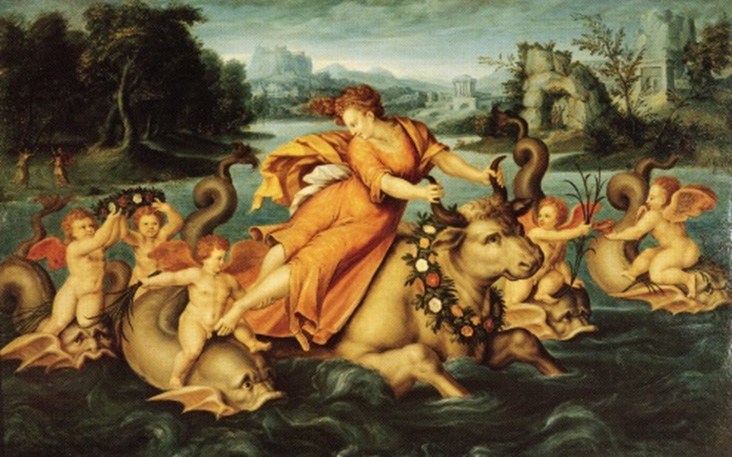Europa and the Bull - The Mystery of Europe
Europe takes its name from the myth of Europa and the Bull. A myth is an allegorical story packed with symbolism and many levels of meaning. Moreover, a myth has the ability to stay alive, grow and evolve, and to act as a vehicle or channel for inspiration and higher teachings. When connected to the landscape (as it often is), it is able to convey various insights into and knowledge of that landscape. That is to say, a myth can describe the symbolic form and nature of a landscape as well as its spiritual purpose.
The myth of Europa and the Bull seems to do this in terms of Europe and in the context of our planet as a whole. This appears to be a key to many things, including both planetary and human evolution. It appears to have been known to previous ages and cultures, and is in the process of being rediscovered and worked with in our present times, for the benefit of us all and the whole world.
The myth relates how Zeus fell in love with the beautiful Europa and took on the form of a magnificent white bull in order to win her attention and affection. She subsequently fell in love with him, placed garlands around his neck and climbed onto his mighty shoulders. Zeus promptly took off with her, flying across the dark ocean of the universe to the Earth, where they came to rest in a secret place and made love. The result of their union was the birth of Hermes (Mercury).
Other versions of the myth make Europa the daughter of Agenor, the Phoenician King of Tyre, and Queen Telephassa, and locate the secret place of love-making in Crete. Others say that she was the daughter of Phoenix, the title of Atlas, King of Atlantis, otherwise known as Enoch. In these versions, Zeus swims across the sea.
The myth is in essence the same as that of Osiris and Isis, wherein Isis is Europa and Osiris is the Bull. (Osiris, in Egyptian myth, is represented as a bull.) Horus, the child of Isis, fathered by Osiris, is equivalent to Hermes, the child of Europa, fathered by Zeus (the Bull).
The Christian story of Mary, Joseph and Jesus is based on the same myth, but acted out in the Middle East by the Holy Family. (In Christian symbolism, Joseph is represented by an ox or bull.)
Mercury, the Roman name for Hermes, is another name for Christ, both names being derived from the Ancient Egyptian name for Horus, Maat Kheru, 'The True Word'.
The story is recorded in the stars, wherein Zeus is the zodiacal constellation of Taurus, the Bull, and Europa is the star cluster, the Pleiades. The Pleiades, or 'Seven Sisters', daughters of Atlas, are said to have originally been one very bright star, the most beautiful of the heavens, called Maia ('Mother'). Her name was retained as the name of the eldest and most beautiful of the seven sisters. She was seduced by Zeus and gave birth to Hermes. Maia is another name for Europa as mother of Hermes.
In another sense, Europa relates to the goddess Venus, who is the ruler of Taurus in astrological tradition. She is the mother of Cupid (Greek, Eros).
The zodiacal sign of Taurus rules the throat chakra. Europa, as the Pleiades, rules the alta major chakra. It is the throat that sounds the Word of truth that creates all things. The alta major chakra, known in tradition as 'the Mouth of God' or Pan chakra, is associated with the Holy Breath (Spirit) and is the gateway by which the spiritual breath, as divine inspiration, enters the heart. It is this breath that bears the Word. The physical breath is the reflection or echo of the spiritual breath, being its outer manifestation.
Such a myth is a Mystery. The myth of Europa and the Bull is the Mystery which present-day Europe is engaged in acting out on a continental scale in terms of culture and politics. It is a key to understanding the role of Europe in the world.
The myth is also manifested in the landscape of Europe, which forms a stage for the mystery to be performed.
Further Information: www.zoence.co.uk/philosophy/
